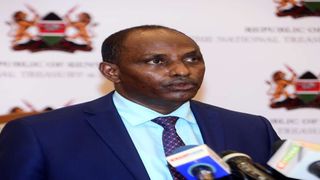
National Treasury Cabinet Secretary Ukur Yatani.
| Salaton Njau | Nation Media GroupBusiness
Premium
Debt-saddled Kenya gets a brief reprieve on loans
What you need to know:
- The National Treasury has not been able to raise enough revenues this year to meet the budget expenses as a result of the coronavirus pandemic.
- Lower revenues mean budget shortfalls and more borrowing even as debt continues to grow out of control.
Kenya has been handed a Sh32.9 billion loan-repayment break by the Paris Club of international creditors from January to the end of June.
East Africa’s biggest economy has joined Tanzania, Uganda and Burundi who have taken the Paris Club freeze since it was announced in May last year.
Rwanda, whose debt distress is rated moderate, has not taken the offer as well as South Sudan and Somalia that are already in distress.
The rich western countries including Belgium, Canada, Denmark, France Germany, Italy, Japan, Republic of Korea, Spain and the US said Kenya will use the savings to fight the Covid-19 pandemic as the country struggles with low tax revenues against spiralling public debt.
“Kenya is committed to devote the resources freed by this initiative to increase spending in order to mitigate the health, economic and social impact of the COVID19-crisis,” the Paris Club said in a statement on its website.
The National Treasury has not been able to raise enough revenues this year to meet the budget expenses as a result of the coronavirus pandemic.
Restrictions on movement
Low economic activity as a result of restrictions on movement including lockdowns and curfews, job losses as well as income and value added tax relief measures offered by the government last year have reduced revenues netted by the Kenya Revenue Authority (KRA).
Exchequer collections fell 15.03 percent, or Sh33.27 billion, in the first two months of the current fiscal year to Sh188.08 billion on prolonged knock-on effects of the Covid-19 containment measures on economic activity.
Lower revenues mean budget shortfalls and more borrowing even as debt continues to grow out of control.
The current debt stands at Sh7.1 trillion or 69.2 percent of the economy, which is almost breaching the 70 percent sustainability levels. Debt repayment in the four months to October 2020 accounted for 58 percent or Sh246.2 billion of the Sh426.3 billion taxes.
In 2019, Parliament tried to stop ballooning debt at Sh9 trillion with a ceiling but, since Kenya is in a deep hole and can only dig itself deeper into the pit, the ceiling is about to be breached and now Treasury wants it moved to Sh12 trillion.
Recovery strategy
In the economic recovery strategy set out by the National Treasury, it will seek to push wealthy countries and multilateral lenders like the World Bank to cancel part of it ballooning public debt.
Kenya has also committed to seek from other bilateral official creditors a debt service treatment that is in line with the agreed terms of the Debt Service Suspension Initiative (DSSI) of the G20 group of rich nations and big emerging powers.
Treasury says Kenya will also rely more on loans arranged from multilateral bodies like the World Bank and the International Monetary Fund since they carry friendly terms with low rates and longer repayment periods.
These loans however come with conditions including structural adjustments programmes, high taxes and cut back on subsidies.
In fact, Kenya only went for the Paris Club freeze after the IMF insisted it was a condition for a $2.3 billion (Sh250.4 billion) soft loan in February.





